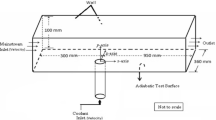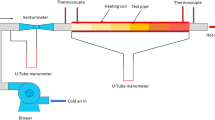Abstract
In such a complex situation as the cavity of two square plates connected to cavities composed of four pipes with same length and different diameter connected in series and parallel, the resistance of cavity of two square plates should be combined with that of pipes to determine the gas direction in gas assisted injection molding (GAIM). The flow model of Newtonian fluid was previously suggested under the fan-shaped geometry incuding relatively thin cavity of two square plates when\(\rho \bar v_r H/\mu \left( {H/R_0 } \right) \ll 1\),\(\left( {H/R_0 } \right)^2 1 / \hat \theta ^2 \ll 1\) and (H/R0)2.However, one may frequently encounter the problem of relatively thick fan-shaped cavity between two square plates where (H/R0)2 is around 10-1 and\(\hat \theta ^2 \) is the order of one. The rule of thumb containing a first order-approximated flow model by perturbation technique was introduced to show, in qualitative way, whether the resistance of the relatively thick cavity of two square plates may affect the gas direction in GAIM under the fore-said geometry. Subsequently, various simulations were performed under the conditions that all dimensions of cavity of two square plates and pipes were fixed except for the diameters of pipes. The results of simulation were compared with the results of the rule of thumb (RT1) containing the approximated flow model as well as those of another rule of thumb (RT2) without the resistance of the relatively thick cavity of two square plates. The results of simulations were generally consistent with the former in qualitative way to determine gas directions in gas assisted injection molding even though a relatively large value of 0.36 was applied as the value of ε to describe a relatively thick cavity of two square plates. In addition, the situation was treated when cavities of pipes and runners were involved in configuration. The rule of thumb was used for the ratio of initial velocities to be recalculated at the first coming change of diameters when the ratio was close to unity and it was quite consistent to the results of simulation.
Similar content being viewed by others
References
Chen, S.-C., Cheng, N.-T. and Hsu, K.-S., “Simulations and Verification of the Secondary Gas Penetration in a Gas Assisted Injection Molded Spiral Tube,”International Communications in Heat and Mass Transfer.,22, 319 (1995).
Chen, S.-C., Cheng, N.-T. and Hsu, K.-S., “Simulations of Gas Penetration in Thin Plates Designed with a Semicircular Gas Channel During Gas Assisted Injection Molding”,Int. J. Mech. Sci.,38, 335 (1996a).
Chen, S.-C., Cheng, Hsu, K.-F., and Hsu, K.-S., “Polymer Melt Flow and Gas Penetration in Gas Assisted Molding of a Thin Part with Gas Channel Design”,Int. J. Heat Mass Transfer,39, 2957 (1996b).
Chen, S.-C., Cheng, N.-T. and Chao, S.-M., “Simulations and Verification of Melt Flow and Secondary Gas Penetration During a Gas Assisted Injection Molding”,International Polymer Processing,14, 90 (1998).
Gao, D. M., Nguyen, K. T., Garcia-Rejon, and Salloum, G., “Optimization of the Gas Assisted Injection Moulding Process Using Multiple Gas-injection Systems,”Journal of Materials Processing Technology,69, 282 (1997).
Khayat, R. E., Derdouri, A. and Herbert, L. P., “A Three-dimensional Boundary-element Approach to Gas Assisted Injection Molding,”J. Non-Newtonian Fluid Mech.,57, 253 (1995).
Lim, K. H., “Flow Direction when Fan Shaped Geometry is Applied in Gas Assisted Molding: 1. Theory of Flow Model and its Criterion to Predict Flow Directions,”Korean J. Chem. Eng.,21, 48 (2004a).
Lim, K. H., “Gas Flow Direction Under Heterogeneous Geometry Composed of a Pipe and a Cavity of Two Square-flat Plates in Gas Assisted Injection Molding”,Journal of Industrial and Engineering Chemistry,10(3), 416 (2004b).
Lim, K. H. and Hong, S. H., “Flow Direction when Fan Shaped Geometry is Applied in Gas Assisted Molding: 2. Development of Flow Model and its Predictions,”Korean J. Chem. Eng.,21, 59 (2004).
Lim, K. H. and Lee, E. J., “Predictions of Gas Flow Directions in Gas Assisted Injection Molding when Cavities and Runners are Involved,”Korean J. Chem. Eng.,20(3), 592 (2003).
Lim, K. H. and Soh, Y. S., “The Diagnosis of Flow Direction under Fan Shaped Geometry in Gas Assisted Injection Molding”,Journal of Injection Molding Technology,3, 31 (1999).
McCabe, W. L., Smith, J. C. and Harriot, P., “Unit Operations of Chemical Engineering,” 4th Ed., McGraw-Hill Press (1986).
Parez, M. A., Ong, N. S., Lam, Y. C. and Tor, S. B., “Gas-assisted Injection Molding: The Effects of Process Variables and Gas Channel Geometry,”Journal of Material Processing Technology,121, 27 (2002).
Shen, Y K., “Study on the Gas-liquid Interface and Polymer Melt Front in Gas Assisted Injection Molding”,Int. Comm. Heat Mass Transfer,24, 295 (1997).
Shen, Y. K., “Study on Polymer Melt Front, Gas Front and Solid Layer in Filling Stage of Gas Assisted Injection Molding”,Int. Comm. Heat Mass Transfer,28, 139 (2001).
Soh, Y S. and Lim, K. H., “Control of Gas Direction in Gas Assisted Injection Molding; Definition of Resistance to Velocity”,SPEANTEC Tec. Papers,60, 482 (2002).
Soh, Y S., “Control of Gas Direction in Gas Assisted Injection Molding”,Journal of Reinforced Plastics and Composites,19, 955 (2000).
Soh, Y. S. and Chung, C. H., “Flow Directions in the Gas Assisted Injection Technology”,Journal of Reinforced Plastics and Composites,17, 935 (1998).
Author information
Authors and Affiliations
Corresponding author
Rights and permissions
About this article
Cite this article
Lim, KH. Flow directions in gas assisted injection molding when cavities of square flat plates and pipes are involved 1. Theory of flow model and its criterion. Korean J. Chem. Eng. 21, 1108–1118 (2004). https://doi.org/10.1007/BF02719482
Received:
Accepted:
Issue Date:
DOI: https://doi.org/10.1007/BF02719482




